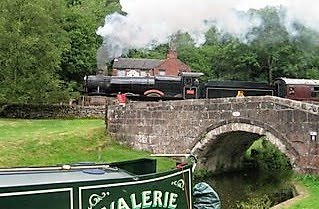St Pancras station built by the Midland Railway Company in 1864 and completed four years later. The front was constructed as the Midland Grand hotel to bring more revenue to the railway company.
It is also still the terminus for Midland mainline trains and below ground is the Thameslink line that links the north of London to the south. Also deep below ground are the six underground lines that serve this and next door Kings Cross stations.
The lower level once served as storage space that was rented from the railway company but is now a mini shopping centre. The iron girder arch designed by William Barlow spans the platforms and is 698 feet long, 240 feet wide and a 100 feet high. It was at the time the largest enclosed space in the world. In the 1960`s under the ownership of our nationalised rail company `British Railways` (remember them) it was planned to demolish it. Sir John Betjeman fought tooth and nail -where does that saying come from?- to save it and it was eventually made a Grade I listed building and a fine Victorian Gothic building survives.
 |
| Sir John Betjeman |
 |
| `The meeting place` by Paul Day |
Below a few of the scenes around the base of the Paul Day Meeting Place sculpture.
History link.
Pictures link
Re- furbished hotel link







6 comments:
Wonderful photographs of a truly superb restoration! You two are having fun, in London town!
Please continue!
Les,you asked for it!
FIGHTING TOOTH AND NAIL - "Fight fiercely, with all one's resources; cling tenaciously. A Latin proverb expressed this thought as 'dentibus et vnguibus.' In the sense of fighting, it appeared in English in 1562 in Ninian Winget's 'Certain Tractates': 'Contending with tuith and nail (as is the prouverb).' In the sense of holding fast, it is equally old, as in Erasmus' 'Enchiridion Militis Christiani' (1533): 'Take and holde this toth and nayle, that to be honour onely which springeth of true virtue.'" From "The Dictionary of Cliches" by James Rogers (Ballantine Books, New York, 1985
In A Dialogue of Comfort and Tribulation, which Sir Thomas More wrote while awaiting execution in 1535, he created a fictional conversation between Anthony, a wise old man, and Vincent, a young man fearful that invading Turks might kill him if he didn’t betray his Christian faith. Anthony argues that some men love the delights of the world so much that “they would faine kepe them as long as ever they might, even with tooth and naile,” but thereby lose the greater gifts of heaven.
Robert Hendrickson, Encyclopedia of Word and Phrase Origins, 2nd edition (New York: Facts on File, 2004), p. 728:
tooth and nail. The Latin equivalent for this ancient phrase was toto corpore atque omnibus ungulis, "with all the body and every nail." The French have a similar saying, too: bec et ongles, "beak and talons." All mean the same: to fight with tooth and nails, biting and scratching, with weapons, with all the powers at one's command. Figurative use of the expression in England brings us back to the early 16th century, and it was listed as a proverb then.
The Latin phrase occurs at Cicero, Tusculan Disputations 2.24.56 (toto corpore atque omnibus ungulis, ut dicitur, contentioni vocis adserviunt), where the ut dicitur shows that it was proverbial in his day.
James Rogers, The Dictionary of Cliches (New York: Ballantine Books, 1985
FIGHTING TOOTH AND NAIL - Fight fiercely, with all one's resources; cling tenaciously. A Latin proverb expressed this thought as 'dentibus et vnguibus.' In the sense of fighting, it appeared in English in 1562 in Ninian Winget's 'Certain Tractates': 'Contending with tuith and nail (as is the prouverb).' In the sense of holding fast, it is equally old, as in Erasmus' 'Enchiridion Militis Christiani' (1533): 'Take and holde this toth and nayle, that to be honour onely which springeth of true virtue.'
The Latin original of Erasmus' Enchiridion (9.5) does not use the tooth and nail phrase:
hoc mordicus teneto solum eum honorem esse, qui a vera virtute proficiscitur.
It's possible to find ancient equivalents closer to the modern English tooth and nail, e.g.
Lucretius 5.1284:
Ancient weapons were hands, nails, and teeth.
arma antiqua manus ungues dentesque fuerunt.
Lucian, Dialogues of the Dead 11.4:
But gold they would guard with teeth and nails and any other way.
τὸ δὲ χρυσίον ὀδοῦσι καὶ ὄνυξι καὶ πάσῃ μηχανῇ ἐφύλαττον.
Love to Jaq,
Ken &Sue nb Cleddau
Lovely pictures. I just love this building and its fabulous architecture.
Love your blog!
Hi Bryce
Yep London is always full of things to see and do.
Hi Sue Maybe I should not have asked but thanks anyway.
Hope you are both well and that we might meet again in the not to distant future.
Les
Hi Snowy Owl
Yes it is a wonderful building and far to many buildings disappear for the sake of profit. This building survived and the Eurostar is running within it.
Post a Comment